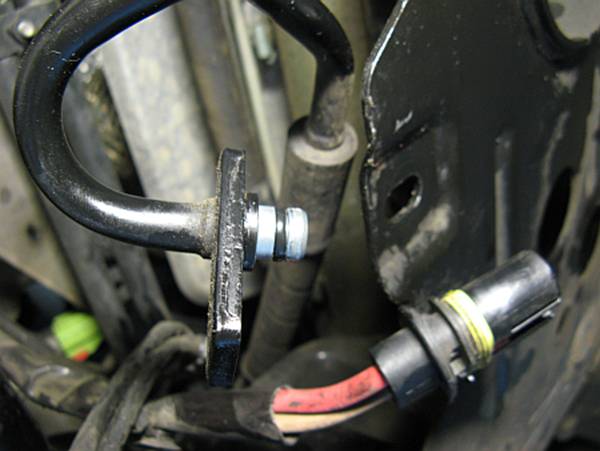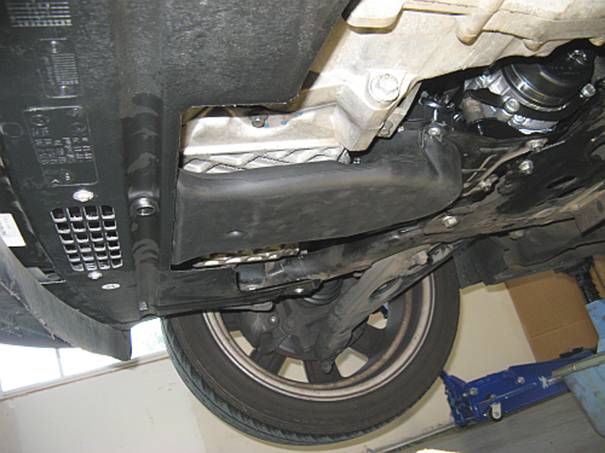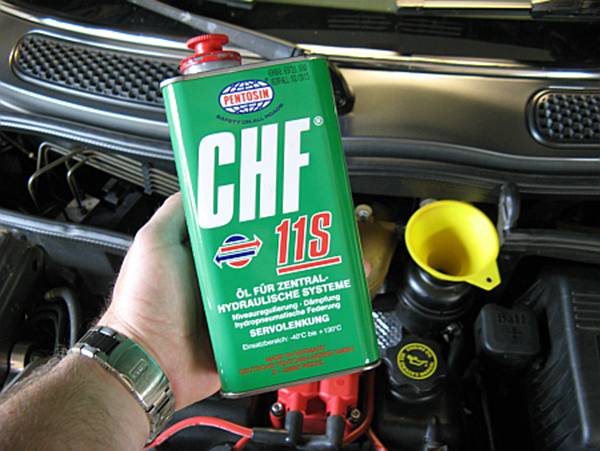R50-R53 Mini Cooper
Power Steering Pump / Fan / Duct
Replacement and Installation
The power
steering pump and fan are known issues with our Mini Coopers. My pump died a
short while after I purchased my pre-owned Mini with 110k miles on the clock.
The fan still worked but felt rough when turned by hand off the car at certain
points, I figured since the pump was being replaced the fan was cheap
insurance. I also purchased the OE duct for the fan to offer some protection
from road debris.
Standard
Disclaimer: ANY USE OF THIS INFORMATION
BY YOU IS AT YOUR OWN RISK.


To start,
I disconnected the battery by removing the ground cable using a 10mm
socket/ratchet. You may want to place a shop rag or newspaper over the latch so
the hatch will not lock, if it does you will have to use the manual release
under the rear seat:


I used my
Topsider to vacuum the power steering reservoir dry. I was also able to get it
down the suction hose from inside the front of the reservoir to drain all the
fluid out of that tube. No such luck with the rear hose since the baffle in the
reservoir was blocking access.




The car
was jacked up using the common piece of wood under the chassis rail with jack
technique (technique in more detail on NAM), this allowed jack stands
to be placed at the factory jack points. Be sure to get the car high enough so that
you have room to work. Also, the parking brake should be on and the rear wheels
chocked prior.


The fan is
removed using a 13mm socket wrench, two bolts hold the fan to the pump bracket.
The wiring harness plug is released by pressing on the tab and pulling.



On to the
power steering pump- The first thing removed were the two top bolts holding the
Power Steering Pump (PSP) in. The first pic below shows a view of the back of
the front subframe where the cat resides, going closer and at a higher angle
you will see two bolts that need to be removed (the orange sticker is a good
reference point when looking at the pics). I used a 13mm socket and a 3/8”
ratchet with two small extensions to remove these, once you know where they are
at you can remove/install these by feel:




If you
look above the motor mount at the passenger side of the PSP, you will see the
wiring harness retainers pushed into two holes on the PSP bracket, these can be
pushed up and out of the bracket:

The
suction hose clamp can be removed by inserting a flat bladed screwdriver in the
clamp recess and twisting- you may have to twist both ways a few times to get
it loose and then pry the clip apart:

The lower center
bolt holding the PSP bracket to the car can be removed using a 13mm wrench:

The small
wiring harness plug at the top of the PSP can be removed by pressing down the
clip and pulling off:


The
pressure hose is held to the PSP by a bolt that will need to be removed, using
a 13mm wrench. After the bolt is removed, it will take a bit of pulling to get
the hose fitting out of the PSP, it is a precision fit and there is an O-ring
(see arrow in pic) on the hose fitting. Don’t lose the O-ring unless you have a
new one to replace it (which might not be a bad idea, P/N 32416762724, 8mm x
2mm, #15 illustrated HERE). Have an oil pan and some shop towels ready as this
hose was the one not accessible to drain and there will be a bit of fluid. The
suction hose (the one with the clamp I had to pry apart) can be pushed up and
off of the pump, not much fluid in that one other than a few drops thanks to
the Topsider:



Take a
break while the fluid is draining, after it is down to a drip you can remove
the PSP with bracket. Some forum guys have used a Dremel tool to slot the lower
bolt hole to make this easy to slide out. I found that by tucking all wiring to
the side and pushing the hard line out of the way, the pump could be tilted
toward the front of the car and pushed up and over the subframe bolt hole- it
IS tight but there is enough room to clear the bolt hole without any
modification (unless you want to). Once the PSP and bracket have been wedged
clear of the subframe, the main power connection plug can be removed by pulling
out. It looks like this plug has retainers but they give with pulling force, no
prying needed:

The pump
bracket is removed using a 10mm wrench, 4 nuts total:



With the
above bracket removed I was able to access the other bracket that will need to
be removed using a T40 Torx socket, 2 bolts total:



Brackets are
attached to new pump (after cleaning them up a little first):



You will
need to source a 1” hose clamp to replace the non-usable OE clamp that was
removed from the suction hose. I went ahead and pre-tightened this clamp a bit
and placed it up the suction hose and on the hose heat shield so it would stay
in place while the new pump was installed. I also cleaned up the pressure hard
line connection making sure no dirt was on the O-ring and surrounding area:


Before
attempting to reinstall the new pump, the pressure port plug is removed- you
will not be getting this out with the pump in place. The suction port cap is
left in place since it is easily removed once the pump is in place and will
only help to keep dirt out when reinstalling. The pump is installed the same
way it was removed: the main power harness is plugged in; pump is installed by
rotating it into position and the lower bolt into the hole. Once in position,
the top rear bolts are installed first- I used a shop light to visually line up
the bracket holes and then used the socket wrench extension/13mm socket to get
the bolts hand started, then tightened using a ratchet. Next the lower bolt is
tightened using a 13mm wrench. The pressure/hard line is pushed in (it is a
good idea to lube the o-ring with some new power steering fluid prior to
assembly so it will slide into place) and that retaining bolt inserted/started
by hand/tightened using a 13mm wrench- you may have to rotate the hard line
around to get the hole to line up with the bolt hole. The suction hose is
pulled down and over the male hose fitting on the PSP after removing the
protective cap, and the hose clamp put in place and tightened- not gorilla
tight since the hose fitting on the PSP is plastic. The smaller wiring harness
connector is plugged into the PSP, not to be confused with the fan wiring
harness plug. Do not forget to also push the two wiring harness plastic
retainers back into the bracket holes on the passenger side.


I bought a
new fan that has to be installed on the fan bracket. Since this fan is a
standard SPAL P/N and not the Mini specific part, new screws and bolts will
have to be sourced (the standard fan screw holes are too large for the Mini
screws) and the Mini fan connector cut off the old fan and spliced into the new
fan wiring harness.
I was able
to find three of the same slightly larger sheet metal screws to hold the new
fan to the mount until I get to the hardware store
to
purchase 4 new bolts/nuts/washers for a permanent fix. The connector on the old
fan was cut far enough back to leave plenty of wire to splice into the new fan
wiring harness. I removed the spade clips from the new fan connector and cut
them off to maximize wire length there as well. I used crimps and a crimping
tool to splice the connector and wiring harness but you may want to solder or
both- my personal experience has shown crimps only to work well in automotive
use- YMMV.




The grille
is removed from the fan by carefully flexing it out and off, this is no longer
needed and would interfere with the duct I am installing.
You will also notice that where the duct screws would go, there are two square
voids where the OE “screw” retainers (P/N 07146981767 x 2, #8 illustrated HERE) would clip into place . Since I did not get those
pieces, I found some sheet metal screw clips that would work but may order the
OE pieces. The OE “screw” retainers were removed from the duct so that standard
screws could be used. If you have an older fan bracket that does not have the
duct provision, you may have to drill holes and change out the screws like I
did. Note the water drain hole in the duct. The fan is plugged in and
reinstalled using a 13mm wrench for both nuts.
[UPDATE: I
did order and install the OE “screw” retainers for the fan mount- pictures
below updated to reflect this]






The duct
requires a new piece to be installed in front. The old piece is removed by
loosening (but not much and not removing) bolts at the leading edge, by
releasing the “screws” on either side, and then pulling back and out:



The new
panel is pushed into place and the bolts/screw retainers tightened. The duct is
placed above the new panel vent and the screw retainers tightened, then the
screws are tightened at the fan bracket:


Don’t
forget to reconnect the battery. Last but not least, Pentosin CHF 11S fluid is
added to the power steering fluid reservoir. I started at a little over half a
can (add until it reads on the stick between the first and second line) and
added more as the bleeding process took place. Bleeding is accomplished by
having a helper start the car while it is still on jack stands and turning the
wheel from full lock left to full lock right a few times. You don’t want to do
this with the wheels on the ground and loaded as it might stress the pump until
you get the fluid in and the air out. Check fluid periodically on the stick,
add if fluid is not between marks, and repeat until satisfied. This is also a
good time to check for leaks. After I was happy with the bleeding process, had
lowered the car off jack stands, gone for a drive, and then returned home to
check the fluid I probably used ¾ of one can. The fluid level is good when it
is between the first and second lines on the dipstick when warm:


After cleaning everything up you
can enjoy your Mini with power steering again J
For more information on products
used in this DIY guide and where they were sourced, check out my Mini website
at www.billswebspace.com/mcs.htm
For
more information on cleaning your PSP motor, check out this Mini2 thread HERE